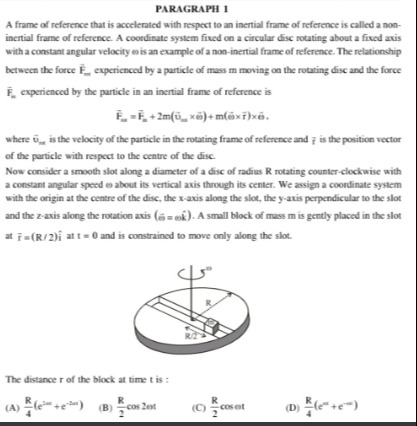Question
Question: A frame of reference that is accelerated with respect to an inertial frame of reference is called a ...
A frame of reference that is accelerated with respect to an inertial frame of reference is called a non-inertial frame of reference. A coordinate system fixed on a circular disc rotating about a fixed axis with a constant angular velocity ω is an example of a non-inertial frame of reference. The relationship between the force Frot experienced by a particle of mass m moving on the rotating disc and the force Fin experienced by the particle in an inertial frame of reference is
Frot=Fin+2m(vrot×ω)+m(ω×r)×ω.where vrot is the velocity of the particle in the rotating frame of reference and r is the position vector of the particle with respect to the centre of the disc.
Now consider a smooth slot along a diameter of a disc of radius R rotating counter-clockwise with a constant angular speed ω about its vertical axis through its center. We assign a coordinate system with the origin at the centre of the disc, the x-axis along the slot, the y-axis perpendicular to the slot and the z-axis along the rotation axis (ω=ωk^). A small block of mass m is gently placed in the slot at r=(R/2)i^ at t=0 and is constrained to move only along the slot.
The distance r of the block at time t is:

4R(eωt+e−2ωt)
2Rcos2ωt
2Rcosωt
4R(eωt+e−ωt)
4R(eωt+e−ωt)
Solution
Equation of motion in the rotating frame
We use the effective forces:
- Coriolis force yields no x-component since vrot∥i^.
- Centrifugal force gives
Thus along the slot,
mx¨=mω2x⟹x¨−ω2x=0.General solution
x(t)=Aeωt+Be−ωt.Initial conditions
x(0)=2R ⇒ A+B=2R,x˙(0)=0 ⇒ A=B.Hence A=B=4R and
x(t)=4R(eωt+e−ωt).